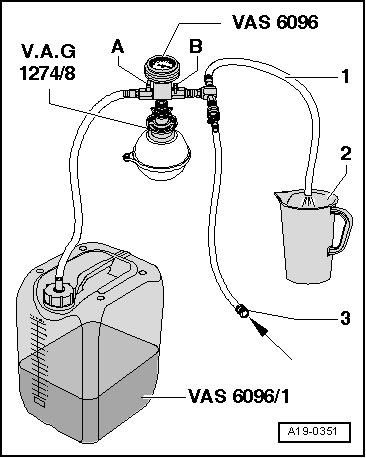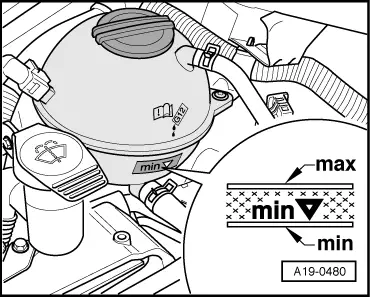
Note | An influencing factor of the effectiveness of the coolant is
the amount of water used. Due to the various qualities in the various
countries Volkswagen has decided to define the quality of the water
to be used in the coolant system. Distilled water fulfils all requirements.
It is therefore recommended that distilled water be mixed with the
coolant whenever an older model's coolant is replenished or replaced.
For new models (model year 2010 ►) the use of distilled water is absolutely
essential and compulsory. |

Caution | It is only permissible to use distilled water for mixing with
G12 plus-plus. The use of distilled water ensures optimum protection
against corrosion. |
|

Note | t
| Only use coolant additive G 12 plusplus in accordance with
TL VW 774 G |
| t
| It is only permissible to use distilled water for mixing. |
| t
| Coolant additives marked „in accordance with TL VW 774 G“ prevent lime accretion, frost damage and corrosion. Moreover, the
boiling temperature is raised. Therefore, the cooling system must
be filled all year round with coolant additive. |
| t
| Because of its higher boiling point, the coolant improves engine
reliability under heavy loads, particularly in countries with tropical
climates. |
| t
| Frost protection is required down to about -25 °C (in countries
with arctic climates: down to about -35 °C). |
| t
| The coolant concentration must not be reduced by adding water
even in warmer seasons and in warmer countries. The coolant additive
concentration must be at least 40 %. |
| t
| If a stronger anti-freeze mixture is necessary due to harsher
weather conditions, it can be increased using G 12 Plusplus. It may
only be strengthened, however, to 60 % (antifreeze protection to about
-40 °C). Otherwise, the antifreeze protection will be reduced again
and the cooling effect will be impaired. |
| t
| If radiator, heat exchanger, cylinder head or cylinder head
gasket is renewed, do not reuse old coolant. |
| t
| The refractometer -T10007- is recommended
for determining the current anti-freeze density. |
| Recommended mixture ratios: |
|
|
|
 Note
Note

 Note
Note
